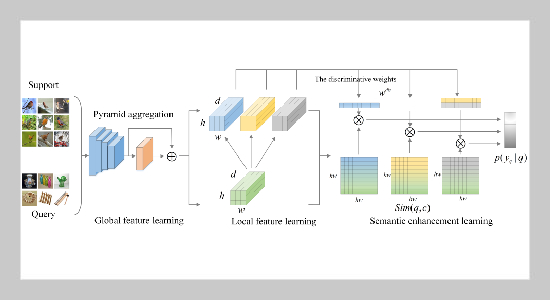- [1] J. Y. Lim, K. M. Lim, C. P. Lee, and Y. X. Tan, (2023) “SCL: Self-supervised Contrastive Learning for Few-shot Image Classification" Neural Networks: 19–30. DOI: 10.1016/j.neunet.2023.05.037.
- [2] J. Gao, P. Li, A. A. Laghari, G. Srivastava, T. R. Gadekallu, S. Abbas, and J. Zhang, (2024) “Incomplete multiview clustering via semidiscrete optimal transport for multimedia data mining in IoT" ACM Transactions on Multimedia Computing, Communications and Applications 20(6): 1–20. DOI: 10.1145/3625548.
- [3] Y. Dong, H. Zhang, C. Wang, and Y. Wang. “Fine�grained Ship Classification Based on Deep Residual Learning for High-resolution SAR Images”. In: Inter�national Conference on Learning Representations, Remote Sens. 2019, 1095–1104. DOI: 10.1080/2150704X.2019.1650982.
- [4] X. Wei et al., (2022) “Fine-grained Image Analysis with Deep Learning: A Survey" IEEE Trans. Pattern Anal. Mach. Intell. 8927–8948. DOI: 10.1109/TPAMI.2021.3126648.
- [5] P. Li, A. A. Laghari, M. Rashid, J. Gao, T. R. Gadekallu, A. R. Javed, and S. Yin, (2022) “A deep multimodal adversarial cycle-consistent network for smart enterprise system" IEEE Transactions on Industrial Informatics 19(1): 693–702. DOI: 10.1109/TII.2022.3197201.
- [6] P. Chikontwe, S. Kim, and S. H. Park. “CAD: Co�adapting Discriminative Features for Improved Few�shot Classification”. In: IEEE/CVF Conference on Com�puter Vision and Pattern Recognition. 2022, 14554–14563.
- [7] H. J. Ye, H. Hu, D. C. Zhan, et al. “Few-shot Learn�ing via Embedding Adaptation with Set-to-set Func�tions”. In: IEEE/CVF Conference on Computer Vision and Pattern Recognition. 2020, 8808–8817.
- [8] C. Zhang, Y. Cai, G. Lin, and C. Shen. “DeepEMD: Few-shot Image Classification with Differentiable Earth Mover’s Distance and Structured Classifiers”. In: IEEE Conf. Comput. Vis. Pattern Recog. (CVPR). 2020, 12203–12213.
- [9] W. Li, L. Wang, J. Xu, J. Huo, Y. Gao, and J. Luo. “Revisiting Local Descriptor Based Image-to-Class Measure for Few-shot Learning”. In: IEEE Conf. Com�put. Vis. Pattern Recog. (CVPR). 2019, 7260–7268.
- [10] F. Sung, Y. Yang, L. Zhang, T. Xiang, P. H. Torr, and T. M. Hospedales. “Learning to Compare: Relation Network for Few-shot Learning”. In: IEEE Conf. Com�put. Vis. Pattern Recog. (CVPR). 2018, 1199–1208.
- [11] X. Luo, H. Wu, J. Zhang, L. Gao, J. Xu, and J. Song. “A closer look at few-shot classification again”. In: Inter�national Conference on Machine Learning. 2023, 23103–23123.
- [12] Y. B. Liu, L. C. Liu, X. H. Wang, M. Yamada, and Y. Yang, (2023) “Bilaterally Normalized Scale-consistent Sinkhorn Distance for Few-shot Image Classification" IEEE Trans. Neural Netw. Learn. Syst. 12203–12213.
- [13] A. Afrasiyabi, H. Larochelle, J.-F. Lalonde, and C. Gagné. “Matching Feature Sets for Few-shot Image Classification”. In: Proc. IEEE/CVF Conf. Comput. Vis. Pattern Recognit. 2022, 9014–9024.
- [14] C. Finn, P. Abbeel, and S. Levine. “Model Agnos�tic Meta-Learning for Fast Adaptation of Deep Net�works”. In: ICML. 2017, 1126–1135.
- [15] K. Lee, S. Maji, A. Ravichandran, and S. Soatto. “Meta-Learning with Differentiable Convex Opti�mization”. In: CVPR. 2019, 10657–10665.
- [16] A. Nichol, J. Achiam, and J. Schulman, (2018) “On First-Order Meta-Learning Algorithms" CoRR abs/1803.02999:
- [17] Y. Tian, Y. Wang, D. Krishnan, J. B. Tenenbaum, and P. Isola. “Rethinking Few-shot Image Classification: A Good Embedding is All You Need?” In: Computer Vision – ECCV. 2020.
- [18] N. Lai, M. Kan, C. Han, X. Song, and S. Shan, (2021) “Learning to Learn Adaptive Classifier-Predictor for Few�Shot Learning" IEEE Trans Neural Netw Learn Syst: 3458–3470. DOI: 10.1109/TNNLS.2020.3011526.
- [19] Y. Yu, D. Zhang, and Z. Ji. “Masked Feature Gen�eration Network for Few-Shot Learning”. In: IJCAI. 2022, 7005–7014.
- [20] Y. Jian and L. Torresani. “Label Hallucination for Few-Shot Classification”. In: AAAI. 2022, 3695–3701. DOI: 10.1609/aaai.v36i6.20659.
- [21] A. Antoniou, A. Storkey, and H. Edwards. “Data Augmentation Generative Adversarial Networks”. In: AAAI. 2018, 1050.
- [22] R. Kwitt, S. Hegenbart, and M. Niethammer. “One�shot Learning of Scene Locations via Feature Trajec�tory Transfer”. In: CVPR. 2016, 78–86.
- [23] L. X, W. J, S. Z, et al., (2020) “BSNet: Bi-similarity Network for Few-shot Fine-grained Image Classification" IEEE Transactions on Image Processing: 1318–1331. DOI: 10.1109/TIP.2020.3043128.
- [24] C. Dong, W. Li, J. Huo, et al. “Learning Task-aware Local Representations for Few-shot Learning”. In: IJCAI. 2021, 716–722.
- [25] B. Q, R. I, and A. R. “Improving Few-Shot Learning Through Multi-task Representation Learning The�ory”. In: Computer Vision–ECCV. 2022, 435–452.
- [26] H. Huang, J. Zhang, L. Yu, J. Zhang, Q. Wu, and C. Xu, (2021) “TOAN: Target-oriented alignment network for fine-grained image categorization with few labeled sam�ples" IEEE Transactions on Circuits and Systems for Video Technology 32(2): 853–866.
















